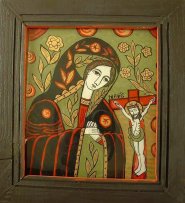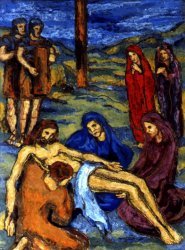Stabat Mater Dolorosa - Pergolesi, Scarlatti & Vivaldi

Here's a trio of Stabat Maters I've long been wanting to post; the fact my previous post contains one track bearing the same title gave me the chance to follow up in a consistent fashion. The Stabat Mater is an absolute personal favourite when it comes to the sublime cantate art form. Hope you like them!
Giovanni Battista Pergolesi (1710 – 1736)
Alessandro Scarlatti (1660 – 1725)
Antonio Vivaldi (1678 – 1741)
 The Stabat Mater Hymns
The Stabat Mater HymnsThe opening words of two companion hymns, one of which (Stabat Mater Dolorosa) is in liturgical use, while the other (Stabat Mater Speciosa) is not. They celebrate the emotions of Our Lady at the Cross and at the Manger -- Calvary and Bethlehem -- respectively, and may conveniently be differentiated here by the third word (Dolorosa, Speciosa). The Speciosa contains thirteen (double) stanzas of six lines; the Dolorosa, ten. In what follows only the Stabat Mater Dolorosa will be dealt with.
The hymn was well known to all classes by the end of the fourteenth century. If the very questionable ascription to Jacopone da Todi is correct, the hymn probably found its way from Franciscan houses into those of other religious bodies and into popular use. It is found in several European (but not English) Missals of the fifteenth century, but was not introduced into the Roman Breviary and Missal until 1727 (Feast of the Seven Dolours B. V. M., assigned to Friday after Passion Sunday).
The authorship of the hymn has been ascribed to a number of men, the most probable being Pope Innocent III (one of the greatest popes of the Middle Ages, born 1160 or 1161 and died 16 June 1216) and Jacopone da Todi, more properly called Jacopo Benedetti (a Franciscan poet, born in the first half of the thirteenth century and died about 1306).
A large literature has grown about the hymns, Protestants sharing with Catholics a deep, and often glowingly expressed, admiration for its pathos, its vividness of description, its devotional sweetness and unction, its combination of easy rhythmic flow with exquisite double rhyming and finished stanzaic form. Because of its vividly epic and lyric character, the hymn has received multiform musical setting. There are literally hundreds of versions extant, as you can discover on a website created by the recently deceased Dutchman Hans van der Velden, who personally owned 211 Stabat Mater cds.
 Pergolesi & Scarlatti
Pergolesi & ScarlattiPergolesi’s health already undermined by a form of tuberculosis, he was being cared for at a Fransiscan monastery in Pozzuoli where he worked at the score of his last piece, the Stabat Mater, putting the final touches to it only days before his death on 16 March 1736. He was 26. His Stabat Mater had become a symbol of the perfection and universality of Italian music – “Such is the fascination of Italian music that when you listen to it you desire no greater happiness in the world,” wrote Charles de Brosses (influential C18 French intellectual).
Scarlatti was less fortunate, having to pay the price of all who are left behind by changes of taste and fashion. His Stabat Mater lost out simply for being informed by his innate qualities of scholarship and profound musicianship.
Whereas Pergolesi tends to reduce and differentiation of voices and instruments, allowing increasingly pure, simple melody, Scarlatti’s predilection for extremely dense textures and for harmony rather than melody (the latter being the more “modern” style at the beginning of C18) often led to ingenious polyphonic and contrapunctal development.
To help you compare these two brilliant yet divergent artists, I’ve scanned in the texts of the hyms, which are identical in both versions. This way you can compare for yourself the way both composers illustrate, e.g. the sword-blows (#2, #14) or the death sight (#6, #20), or any other stanza you would like to delve deeper into.
Finally, whereas in both cases castrati would almost certainly have been used in the original performances, the choice in this recording fell on two female voices (Sara Mingardo – contralto; Gemma Bertagnolli – soprano). The conductor, Rinaldo Alessandrini, felt that the closest thing to the now-vanished castrato the modern world possesses, i.e. the countertenor voice, was completely unknown at the time, or at least was never heard in a solo situation, and would therefore entail minimal fidelity to the sound world of the castrato.
 Vivaldi
VivaldiThe priest Vivaldi, in view of his wild red hair often called "the red priest" (Il Preto Rosso), worked the largest part of his life as a music master at the Ospedale della Pietà in Venice, originally an orphanage for extra-marital girls. For an important part this may not only have influenced the score of his works (there were only women to play and sing), but could also be the reason for the fact that he frequently made use of easy to listen to melodies, as these were mostly intended for a young female audience.
Vivaldi set only the more dramatic, first half of the Stabat Mater. His selection of an alto soloist gives the work a suitably dark timbre. Although he wrote a large volume of vocal and instrumental works for an orphanage of young women where he long directed musical activities, this work was apparently written for one of the hundreds of castrati employed in Italian churches at this time. Vivaldi repeats the music of the first three movements for the next three — with no obvious textual reason. Was he seeking a quick way to fulfill a commission or using repetition for musical purposes, or both? In any case, the result is satisfying.
Vivaldi’s intricate writing for strings — famous from his Four Seasons — is evident here as well, most notably in the “Eia Mater” movement. Its persistent, weeping violin figure serves as a counterpoint to the lyrical vocal line. “Fac ut ardeat cor meum” provides a sweet contrast with a swinging, lullaby-like effect that suggests a mother’s love. Also interesting is the whipping figure in the third and sixth movements, and the stabbing chords underpinning the second and fifth movements — both vividly evoke the suffering of Mary at the foot of the cross.
Concerto_Italiano_Rinaldo_Allessandrini_256.part1.rar
Concerto_Italiano_Rinaldo_Allessandrini_256.part2.rar
Antonio_Vivaldi_Gloria___Stabat_Mater_256.rar



8 Comments:
Thank you very much for this good music but "Share and Save" is a Sh*t.
Regards.
K.
..."Store and serve",excuse me.
K.
Okay, but please tell me why - I'm willing to accept any theory, but only provided it has adequate arguments. Which yours doesn't. Sorry.
I just discovered your musicblog, what a wonderful mess! And I enjoy your comments to the music. Keep going!
By the way, store and serve works fine.
Gorgeous... thanks...
Very interesting! Too bad no one has downloaded this excellent music for more than 30 days now... And now they're gone. Would you be so kind as to "up" them once more, Mr Paxjorge? Thanks in advance.
Sure, just give me some time... Expect it before next Monday!
Great! Thanks. I'll be looking forward to it.
Post a Comment
<< Home